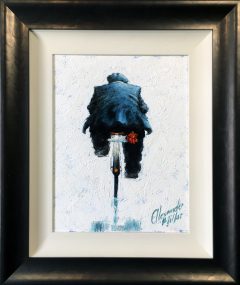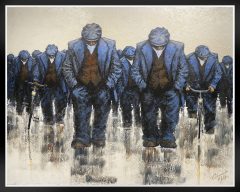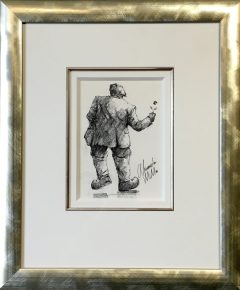Alexander Millar
Showing all 3 results
-

Alexander Millar – Racing Home – Original Oil Painting
£7,999 -

Alexander Millar – The Rat Pack Original Painting
£39,999 -

Alexander Millar – Flower (Sold)
Alexander Millar – Original Paintings & Pencil Drawings for Sale.
ALEXANDER MILLAR
I was born in 1960 into the small mining community of Springside a few miles outside the town of Kilmarnock. Which is on the west coast of Scotland. Life within the small Scottish village was very traditional. Although I grew up in the 60’s era it felt more like the 40’s. My formative years were spent in the company of old men dressed in dark suits smoking woodbines partnered with large missile-shaped women decked out in headscarves and pinnies.
My father worked for British Rail and I got great pleasure from simply sitting in the atmospheric steam filled stations. Which even today I find are the most romantic, nostalgic places to be. Many of my most romantic paintings are set within that very atmosphere. I guess I’m just a big old fashioned nostalgic romantic at heart! It therefore comes as no surprise to many that my favourite film is ‘The Quiet Man’.
Gadgie
I escaped school in 1976 and eventually fled Springside to set myself up in Newcastle-upon-Tyne. This jump from sleepy peacefulness to hustle and bustle was like going from the frying pan straight into the fire. I found Newcastle had, and still has, its fair share of characters locally known as ‘Gadgies’ which fed me much inspiration later on in life when I finally discovered my destiny as an artist. After a number of different jobs I finally settled down in 1988 to become a professional artist. I am completely self-taught. After many years of developing my own style in art I turned to images remembered from my childhood and used the local Tyneside ‘Gadgies.’ As models in my paintings.
The past couple of years have been especially exciting as my work has taken on a life of its own. Sales have gone through the roof and everyone seems to be taking notice of these solitary figures I create. I’m continually surprised to see the effects my paintings have on people. On many occasions I’ve had women moved to tears absorbed by a painting that evokes memories of their father or grandfather.
After a number of sell out exhibitions one of my paintings was entered in the Daily Mail’s ‘Not the Turner Prize’. Ten thousand works were entered and my painting was chosen as one of the finalists which were exhibited at the Mall Galleries in London.
Ideas & Inspirations.
I am fortunate enough in that the things I love to paint are right in front of my eyes everyday. The hairs on the back of my neck still stand on end every time I see an old ‘Gadgie’.
I love the movement of the street drunk. However he remains a difficult subject to paint. Never staying still for any length of time. The real skill comes in trying to capture the just off centre stance of these vertically challenged individuals. The gossiping old ladies standing on street corners. The tired old guy wandering home after a long hard day at work and the wee dog cocking its leg against the street corner are all appealing and interesting to me. I see them all as different choreographed parts in a sort of street ballet.
One of my prize possessions is the oldest, ricketiest, battered bike complete with leather saddle and rusty springs. I bought the antique (I use the term loosely) at a second hand shop for the princely sum of £30.
It is a priceless prop that features in a great number of my paintings.
From Palette to Picture.
After I’ve chosen a figure from my many sketches and photographs it is transferred to my canvas and blocked as a dark silhouette. Each layer of paint is then added gradually to separate tones; the figure is almost complete before the background colour is added.
Having lived in the northern half of Britain all my life I try to capture the subtle light that is particular to that part of the country. The under painting is predominantly blue and then each subsequent layer added is a touch warmer than the last and lifts the painting giving the misty almost ghostlike quality to the background. When this is complete the dark figure leaps out of the canvas. To finish off and give the figure movement I leave the painting for approximately a week and then I take away some of the background colour and feather the legs and soften any harsh edges. I’ll leave the painting in view for a few days in order to see if any adjustments are needed. They usually become apparent to me by then.


